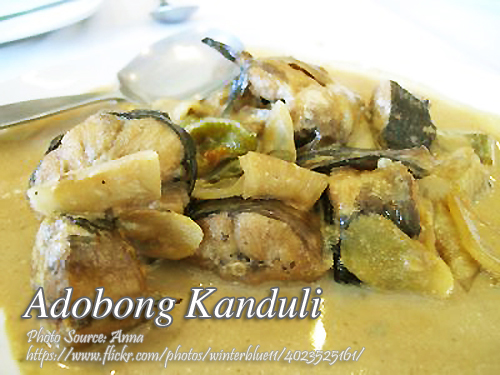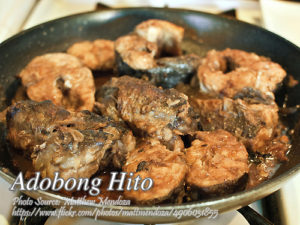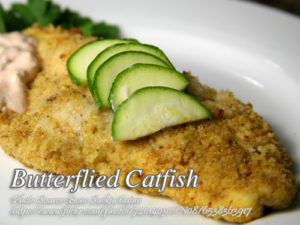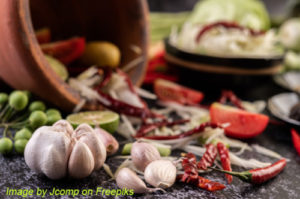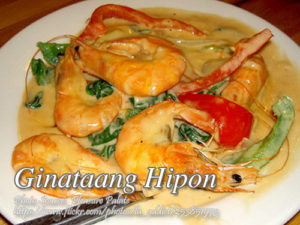Kanduli is one of the kinds of edible catfish. Compared to “hito”, also called catfish but with black skin, kanduli has shiny silvery gray skin with a big head. This fresh water catfish is abundant on placed near Laguna lake. This adobong kanduli is not the usual adobo with soy sauce but instead coconut milk is used and the coloring comes from kasubha, similar to saffron to make the color of the dish a little yellowish.
Adobong Kanduli sa Dilaw: A Comforting Dish from the Past
There’s something about traditional Filipino dishes that bring back warm childhood memories. Growing up in my grandmother’s home in Laguna, I remember the distinct aroma of garlic, vinegar, and coconut milk simmering in her clay pot. It was always a sign that lunch was going to be extra special. One dish she often made, especially when my uncle Mang Ruben came home from a fishing trip, was adobong kanduli sa dilaw—a comforting meal that speaks of home, tradition, and the richness of Filipino cooking.
What Makes Kanduli Special?
Kanduli is a type of freshwater catfish that thrives in Laguna Lake. Unlike the more common hito with its dark, almost black skin, kanduli has a silvery sheen and a meatier texture. My aunt, Tita Maring, swore by its delicate yet rich flavor, saying that it absorbed flavors better than any other freshwater fish. The dish isn’t just about the fish, though; it’s about how the flavors come together to create something truly special.
The Secret Behind the Yellow Hue
Most people associate adobo with the deep brown color of soy sauce, but this version skips the toyo entirely. Instead, it gets its golden hue from kasubha, the local safflower that lends both color and a subtle earthy taste to the dish. My grandmother used to say that kasubha gave the dish “init sa tiyan,” or warmth in the belly—making it perfect for cool rainy days. Some might mistake kasubha for turmeric, but while both add color, kasubha has a milder, almost floral aroma that pairs beautifully with coconut milk.
Cooking Adobong Kanduli sa Dilaw
When my cousin Lito first tried making this dish, he made the mistake of adding all the ingredients at once and wondered why it didn’t taste the same as our grandmother’s. The secret, she told him with a laugh, was in the layering of flavors.
First, the kanduli is gently combined with crushed garlic, whole peppercorns, vinegar, and kasubha. The vinegar acts as both a flavor enhancer and a natural preservative, helping the fish stay firm and absorb all the seasonings. If the vinegar is too strong, a bit of water can help balance the sharpness without dulling the flavor.
Once everything is well-mixed, the coconut milk is added, creating that rich and creamy texture that makes this dish so satisfying. The key here is to let the fish simmer gently without stirring too much—disturbing it too soon might break the delicate fillets apart. After a few minutes, the broth thickens, and the dish is ready to serve.
The Comfort of Home in Every Bite
There’s something deeply nostalgic about the combination of vinegar and coconut milk in this dish. The sharp tanginess of the vinegar balances the creaminess of the coconut milk, creating a contrast that makes each bite more interesting. My sister Lina, who moved to Manila for work, says she always craves this dish when she feels homesick. She swears that a spoonful of steaming rice drenched in the golden sauce brings back memories of home, laughter, and family gatherings by the lake.
A Dish That Stands the Test of Time
Like many traditional Filipino dishes, adobong kanduli sa dilaw has stood the test of time. It’s a dish that doesn’t rely on fancy techniques or expensive ingredients—just fresh fish, simple spices, and the wisdom of generations passed down through each pot of simmering goodness. Whether you grew up eating this in the province or are just discovering it for the first time, one thing is certain: this dish embodies the heart and soul of Filipino home cooking.
So the next time you find yourself near a market selling fresh kanduli, take it as a sign. Cook this dish, savor its comforting flavors, and let it remind you of the simple joys of a good meal shared with family. After all, the best dishes are the ones that tell a story, and this one? It tells a story of home.
How to Cook Adobong Kanduli sa Dilaw
Ingredients
- 1 pc big kanduli cleaned and cut into serving portions
- 1/2 head garlic crushed
- 1/2 cup vinegar
- 1 teaspoon dilaw kasubha
- 1 tablespoon salt
- 1/2 teaspoon peppercorn
- 1/2 cup coconut milk
Instructions
How to Cook Adobong Kanduli:
- Combine fish with garlic, vinegar, dilaw (kasubha), salt and peppercorn.
- If the vinegar is too sour, add water.
- Add coconut milk and boil until fish is done. Six servings.
Notes
Cooking Tips:
Use the Right Vinegar for a Balanced Flavor
Vinegar is essential in adobong kanduli sa dilaw, but using the right kind makes all the difference. Native coconut or cane vinegar works best, as it has a mild acidity that enhances the dish without overpowering the delicate fish. If the vinegar is too strong, a little water can help mellow the sharpness while keeping the tangy depth of flavor.Let the Fish Simmer Without Stirring Too Much
Kanduli is naturally tender, so excessive stirring can cause it to break apart before it fully absorbs the flavors. Allow the fish to gently simmer in the coconut milk and vinegar mixture, letting the sauce thicken naturally. If you need to move the fish, tilt the pan slightly or use a spoon to gently baste the sauce over the fillets.Add Kasubha at the Right Time for Maximum Color and Aroma
Kasubha, the secret to the dish’s golden hue, should be added early to fully release its color and mild floral aroma. Allowing it to steep in the vinegar mixture before adding the coconut milk helps extract its deep yellow tones. This ensures that the dish develops a warm, appetizing color without the need for artificial coloring.
